BEJEWELLED ROYALTY: A LOOK AT THE AL THANI COLLECTION
- EIH User
- August 1, 2024
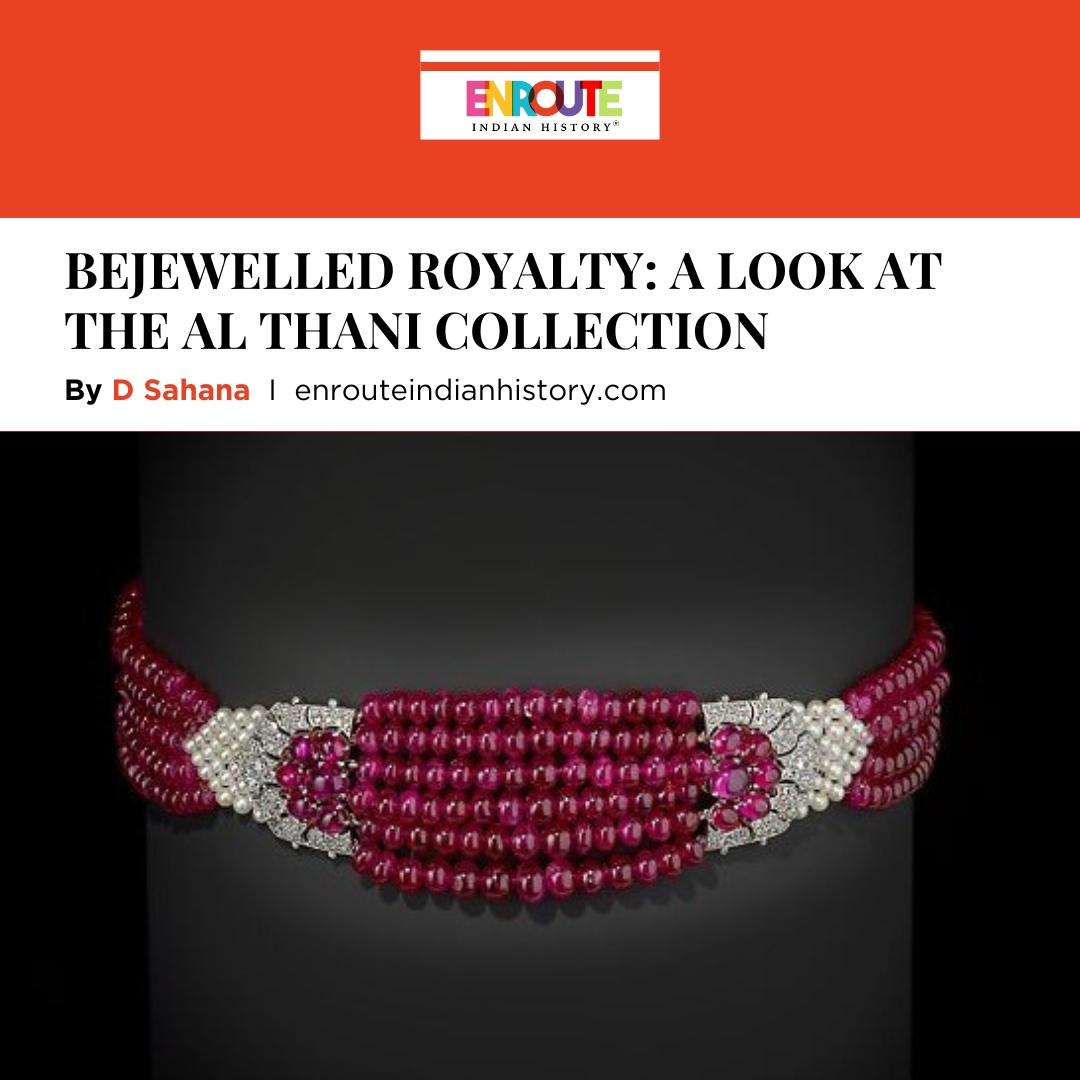
Jewellery is one of the most fascinating artefacts of human beings; it is not just aesthetically pleasing but also wearable and something tangible. Jewellery is made using precious stones, sea shells, wood, etc. Different techniques are used to make various kinds of jewellery. Apart from that, jewellery is also political; it reflects a certain social standing of the wearer, their wealth, their power and influence. This article focuses on the Indian royal jewellery collections of the Al-Thani family. Also, it looks at the symbolism and significance of these royal jewels and the origins and the making of the Al Thani collection.
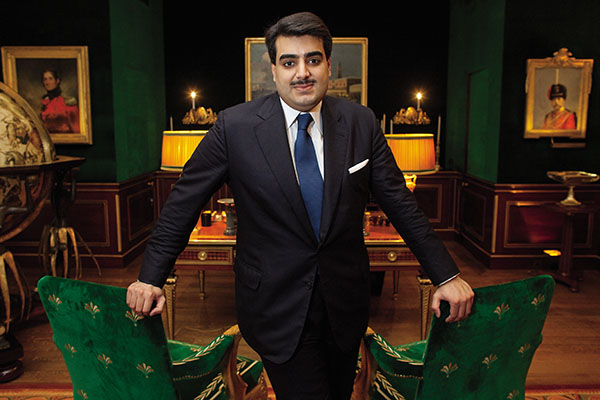
Sheikh Hamad bin Abdullah Al-Thani, the face behind the Al Thani collection
(source:Treasures Of The Maharajas: The Al-Thani Indian Jewellery Collection – Forbes India)
Collecting art and artefacts as an activity has been present for a long time; many collectors have partaken in this activity, and the Al Thani family is no stranger to this. Before we begin looking at the artefacts and origins of the collection, it is essential to understand who the Al Thani family is. The House of Thani is the current ruling family in the State of Qatar. Since Qatar is a monarchical state, it is currently ruled by HH Sheikh Tamim bin Hamad Al Thani, the current Emir of Qatar. The Al Thani collection, which represents different civilisations over a vast time of many centuries, was assembled by Sheikh Hamad bin Abdullah Al Thani, the first cousin of the Emir of Qatar.
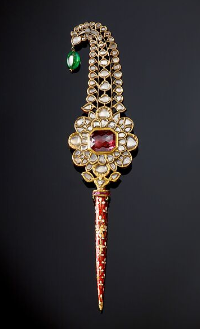
Forehead or Turban Ornament (tika); currently owned by The Al-Thani Collection
Date: c.1900
Made in Punjab
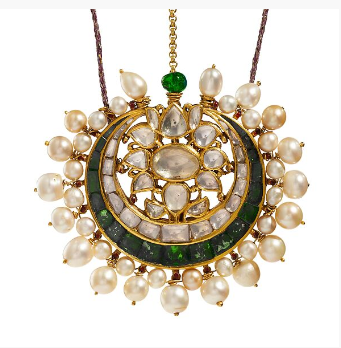
Description: Gold set with emeralds and diamonds with pearls at the end
(source: Forehead or Turban Ornament (tika) | The Metropolitan Museum of Art (metmuseum.org))
THE ORIGINS
The collection first began after the Sheikh visited the 2009 Victoria & Albert Museum’s exhibition named: ‘Maharaja: The Splendour of India’s Royal Courts ’ this exhibit piqued his curiosity as the artistry and the grandeur of the old Indian courts enamoured him. In an interview with Forbes India, he recalled that the piece which impressed him the most at that exhibit was a historic Mughal artefact which was the “Mughal sapphire turban ornament given to Admiral Charles Watson by Nawab Mir Jafar in 1757”.

Mughal sapphire turban ornament presented to Admiral Charles Watson by Nawab Mir Jafar in 1757
Made in Murshidabad
(source: https://collections.vam.ac.uk/item/O67301/turban-ornament/ )
After the exhibit, the idea of the Al Thani collection was born; five years after that exhibit, the Metropolitan Museum of Art held an exhibition titled: ‘Treasures from India’; all works showcased in this exhibit were from the Al Thani Collection. The pieces included jewellery from 16th-century Mughal works to 20th-century Art Deco works of Cartier and Van Cleef & Arpels.
The Al Thani Royal Jewels Exhibition is a travelling one, going from different museums such as the Metropolitan Museum of Art in New York and the Legion of Honor in San Francisco; currently, the highlights of the collection are present for public viewing at the museum space at the Hôtel de la Marine in Paris since November 2021.
WHAT DOES THE COLLECTION SHOWCASE?
Even though the focus of this article is on royal Indian jewellery, the Al Thani collection also possesses artefacts from different civilisations as well—figurines from Egyptian civilisation, carpet weights from the Han Dynasty, and even Mayan artefacts.
Regarding jewellery, the Al Thani jewellery collection holds works spanning over four centuries. The jewels present are from the Mughals, Rajputs and even the Nizams of Hyderabad.
The Al Thani collection also possesses some of the finest diamond works; most of these works used diamonds sourced from Golconda. The exhibition possesses a 19th-century traditional Sarpech( aigrette) of the Nizam of Hyderabad. Nizams were vassals of the Mughal empire, and their jewellery style reflected this relationship. The Sarpech of the Nizam features a Polki diamond set using Kundan goldwork with Meenakari on the reverse side and tumbled spinel drops.
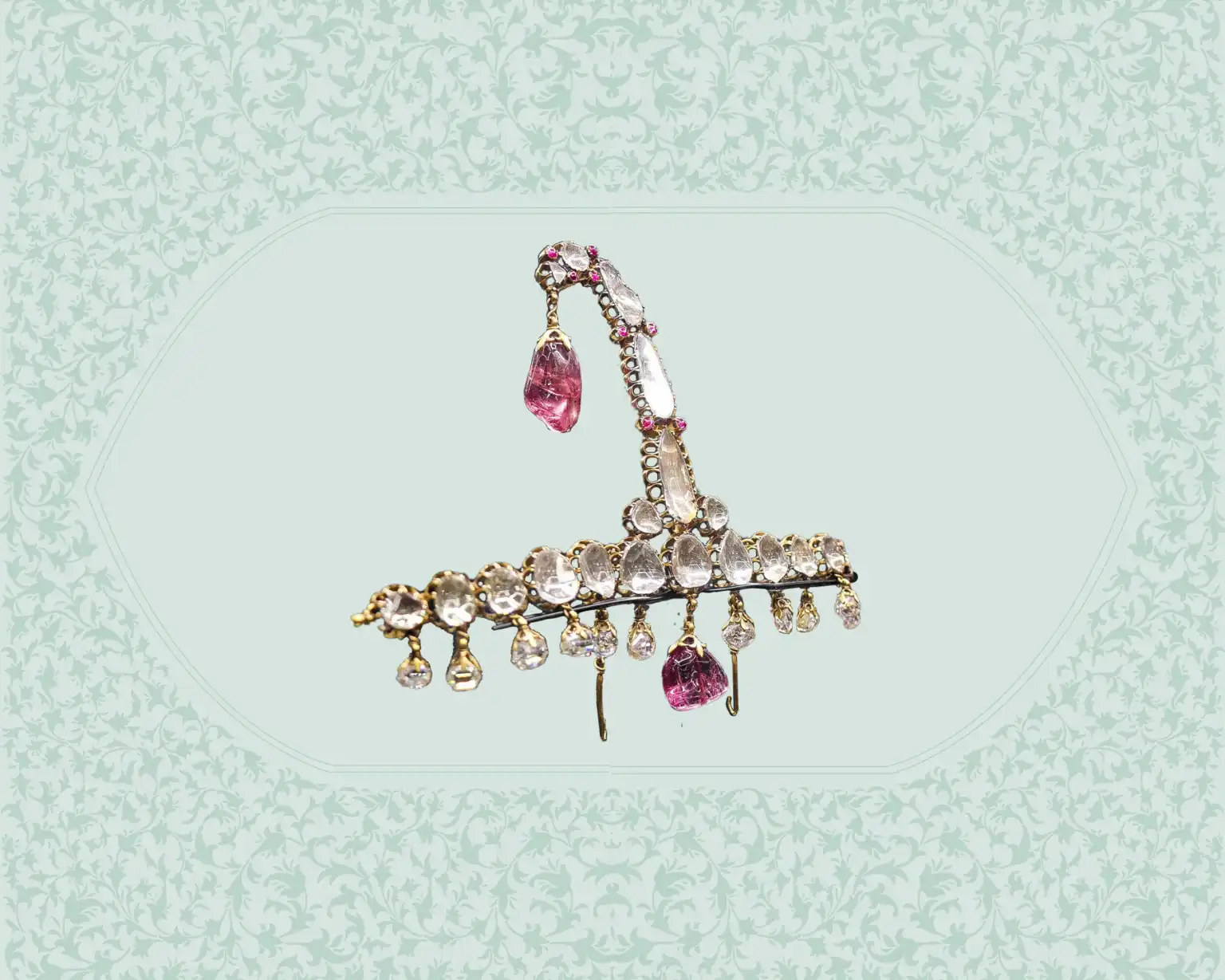
Nizam of Hyderabad’s Sarpech
(Source: Al-Thani Collection: Unveiling India’s Jeweled Legacy Across Centuries (naturaldiamonds.com))
Another diamond aigrette the collection possesses is from the early 20th century and belongs to the Maharaja of Nawanagar. The jewel features 17 enormous natural diamonds weighing 152.64 carats.
Apart from the aigrettes, the collection also contains a finial from the Throne of Tipu Sultan, made of gold and inlaid with diamonds, rubies, and emeralds. Bracelets, bangles, nose rings, earrings etc., are also part of the collection. Finial from the Throne of Tipu Sultan, c.1790; currently owned by The Al-Thani collection

Description: Gold inlaid with diamonds, rubies, and emeralds
(source: Finial from the Throne of Tipu Sultan | The Metropolitan Museum of Art (metmuseum.org))
SHIFT IN STYLE
Since the collection possesses jewels from over four centuries, it also helps us understand the changes in style and preferences regarding jewellery. Since the 20th century, there has been a shift in style and the use of gemstones. It was when many princely state rulers started commissioning jewellery from European makers, such as Cartier and Van Cleef & Arpels. Cartier notably incorporated Indian-carved coloured gemstones, principally emeralds, rubies, and sapphires, to be placed in fashionable Western jewellery in an exotic Indian style today known as ‘Tutti Frutti’, though the name tutti frutti came during the 1970s, it was called ‘pierres de couleur’. Many princely state rulers now wore this new type of royal jewellery collection ,which reflected both the East and the West.
The Patiala Ruby Choker, made by Cartier and commissioned by Maharaja Bhupinder Singh of Patiala in 1931; currently owned by The Al Thani Collection.
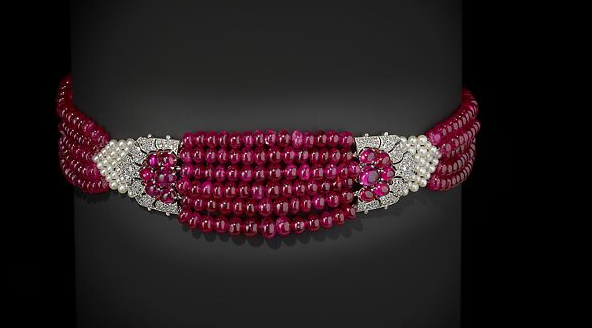
Description: contains rubies, diamonds, and pearls, with platinum mounts
(source: Cartier | The Patiala Ruby Choker | The Metropolitan Museum of Art (metmuseum.org))
SYMBOLS AND SIGNIFICANCE OF THESE JEWELS
Royal Indian jewellery is known for its grandeur, fine detailing, and the use of many precious stones and metals. Jewellery worn by the Indian rulers was an essential part of courtly culture. These rulers wore necklaces, armbands, bracelets, and even anklets. Even their turbans were adorned with jewels made exclusively for the turban, such as the sarpech and jigha. As mentioned, these jewellery also signified the wearer’s social status and the power and influence they yielded.
Gold was one of the most prominent precious metals used by Indian royalty, be it ceremonial ornaments or even jewellery, and it was extensively used. Gold jewellery was made using the Kundan technique, where gemstones were secured using gold stripes instead of claws or prongs. When it came to diamonds, Indian diamonds from Golconda were the most preferred domestically and in global trade, as, until the 18th century, diamonds were mainly procured from India.
Overall, the collection helps us look into the world of Indian royal jewellery and the diversity and change in preferences for styles over different reigns and times.
REFERENCES
FAMSF (2018). https://www.famsf.org/exhibitions/east-meets-west.
Haidar, N.N. and Stewart, C.A. (2014) Treasures from India: Jewels from the Al-Thani Collection. Metropolitan Museum of Art.
Nalley, B.R. (2015) Treasures of the Maharajas: The Al-Thani Indian jewellery collection. https://www.forbesindia.com/article/live/treasures-of-the-maharajas-the-althani-indian-jewellery-collection/39641/1.
The Al Thani collection. https://www.thealthanicollection.com/.
Treasures from India (2022). https://www.metmuseum.org/exhibitions/listings/2014/treasures-from-india.
Brickell, F.C. (2024) The story of Cartier Tutti Frutti jewels, as told by a descendant | jewellery | Sotheby’s. https://www.sothebys.com/en/articles/the-story-of-tutti-frutti-jewels-as-told-by-a-cartier-descendant.
- Al Thani Collection jewels
- Al Thani historic jewels
- Al Thani royal jewels exhibition
- Bejewelled royalty artefacts
- Historic Mughal artefacts
- Mughal jewellery history
- Mughal royal jewellery collection
- Qatar royal artefacts collection
- Qatar royal family jewels
- Qatar royal jewellery collection
- Royal jewellery collections



















